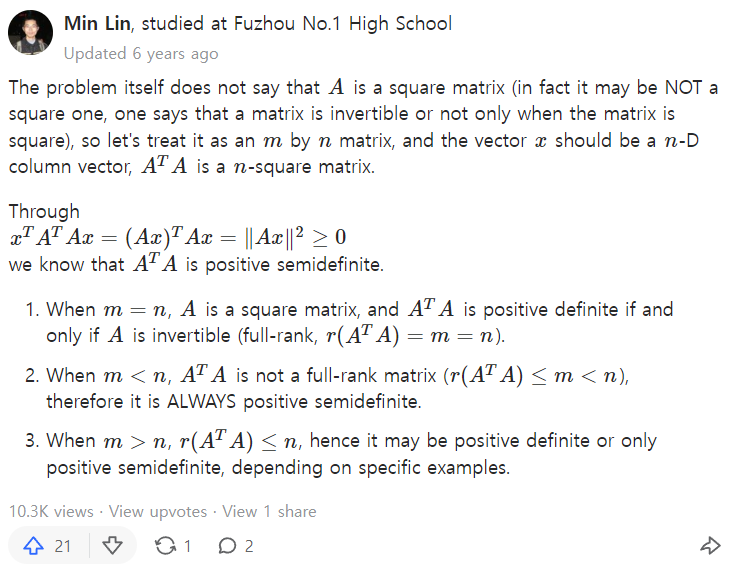(Symmetric) Positive Definite Matrix
Table of contents
- 0. Calculus on Manifolds - Differentiation
- 0+. examples
- 1. Hessian Matrix
- 2. Geometric Meaning of Hessian
- 3. Test for Positive Definiteness (iff conditions)
- 4. Properties
0. Calculus on Manifolds - Differentiation
\[\overrightarrow{\mathbf{f}} : \mathbf{R}^n \rightarrow \mathbf{R}^m\] \[\overrightarrow{\mathbf{x}} \in \mathbf{R}^n : \text{domain}f\] \[\frac{\partial \overrightarrow{\mathbf{f}}}{\partial \overrightarrow{\mathbf{x}}} = \begin{bmatrix} \vert & & \vert \\ \frac{\partial f_1}{\partial \overrightarrow{\mathbf{x}}} & \cdots & \frac{\partial f_m}{\partial \overrightarrow{\mathbf{x}}}\\ \vert & & \vert \\ \end{bmatrix} \text{ : always based on the denominator vectors}\]0+. examples
\[\frac{\partial f}{\partial \overrightarrow{\mathbf{x}}} = \begin{bmatrix} \vert \\ \frac{\partial f}{\partial \overrightarrow{\mathbf{x}}} \\ \vert \\ \end{bmatrix} \text{ : } \frac{\partial \text{scalar}}{\partial \text{vector}}\] \[\frac{\partial \overrightarrow{\mathbf{f}}}{\partial x} = \begin{bmatrix} \frac{\partial f_1}{\partial x} & \cdots & \frac{\partial f_m}{\partial x} \end{bmatrix} \text{ : } \frac{\partial \text{vector}}{\partial \text{scalar}}\] \[\frac{\partial \overrightarrow{\mathbf{f}}}{\partial \overrightarrow{\mathbf{x}}} = \begin{bmatrix} \frac{\partial f_1}{\partial x_1} & \frac{\partial f_2}{\partial x_1} & \cdots & \frac{\partial f_m}{\partial x_1} \\ \frac{\partial f_1}{\partial x_2} & \frac{\partial f_2}{\partial x_2} & \cdots & \frac{\partial f_m}{\partial x_2} \\ \vdots & \vdots & \ddots & \vdots \\ \frac{\partial f_1}{\partial x_n} & \frac{\partial f_2}{\partial x_n} & \cdots & \frac{\partial f_m}{\partial x_n} \\ \end{bmatrix} \text{ : } \frac{\partial \text{vector}}{\partial \text{vector}} \text{ (Jacobian)}\]1. Hessian Matrix
\[f : \mathbf{R}^n \rightarrow \mathbf{R} \text{ (scalar)}\] \[\nabla f = \frac{\partial{f}}{\partial{\overrightarrow{\mathbf{x}}}} = \begin{bmatrix} \vert \\ \frac{\partial f}{\partial \overrightarrow{\mathbf{x}}} \\ \vert \\ \end{bmatrix} \text{ : 1st derivative }\] \[\begin{align*} H &= \begin{bmatrix} \vert & \vert & & \vert \\ \frac{\partial}{\partial \overrightarrow{\mathbf{x}}} \left( \frac{\partial f}{\partial \overrightarrow{\mathbf{x}}} \right)_1 & \frac{\partial}{\partial \overrightarrow{\mathbf{x}}} \left( \frac{\partial f}{\partial \overrightarrow{\mathbf{x}}} \right)_2 & \cdots & \frac{\partial}{\partial \overrightarrow{\mathbf{x}}} \left( \frac{\partial f}{\partial \overrightarrow{\mathbf{x}}} \right)_n\\ \vert & \vert & & \vert \\ \end{bmatrix} \text{ : 2nd derivative.} \\ & = \begin{bmatrix} \dfrac{\partial^2 f}{\partial x_1^2} & \dfrac{\partial^2 f}{\partial x_1 \partial x_2} & \cdots & \dfrac{\partial^2 f}{\partial x_1 \partial x_n} \\ \dfrac{\partial^2 f}{\partial x_2 \partial x_1} & \dfrac{\partial^2 f}{\partial x_2^2} & \cdots & \dfrac{\partial^2 f}{\partial x_2 \partial x_n} \\ \vdots & \vdots & \ddots & \vdots \\ \dfrac{\partial^2 f}{\partial x_n \partial x_1} & \dfrac{\partial^2 f}{\partial x_n \partial x_2} & \cdots & \dfrac{\partial^2 f}{\partial x_n^2} \\ \end{bmatrix} \quad \text{Note that } \left( \tfrac{\partial f}{\partial \overrightarrow{\mathbf{x}}} \right)_i = \tfrac{\partial f}{\partial x_i} \text{ : vector} \end{align*}\]2. Geometric Meaning of Hessian
View Hessian matrix $H$ as a linear transformation.
Let $\lambda$ and $\mathbf{x}$ be eigenvalues and corresponding eigenvectors of $H$.
Then $H\mathbf{x} = \lambda \mathbf{x}$ : direction of $\mathbf{x}$ doesn’t change.
$\mathbf{x}$ represent the principal axis of transformation. (direction)
$\lambda$ represent the degree of transformation. (positive : convex / negative)
Thus,
| eigenvalues | shape of the graph | |
|---|---|---|
| $\forall \lambda > 0$ | convex | positive definite |
| $\exists \lambda > 0$ $\exists \lambda < 0$ | saddle | indefinite |
| $\forall \lambda < 0$ | concave | negative definite |
3. Test for Positive Definiteness (iff conditions)
Let $S$ be a (symmetric) positive definite matrix. Then follows are equivalent.
① $ \forall \lambda > 0 $
② $ \forall \mathbf{x} \ne 0, \ \mathbf{x}^TS\mathbf{x} > 0 $ (Definition)
③ $ \exists A \ s.t. \ S=A^TA $ where $A$ has independent columns.
④ $ \forall D_i > 0 $ where $D_i$ is a leading principal minor (determinant of a leading principal submatrix).
⑤ $ \forall \text{pivot} > 0$
4. Properties
positive definite $\implies$ invertible
pf) For nonzero $\mathbf{x}$, if $H\mathbf{x}=\mathbf{0}$ then $H$ has a $0$ eigenvalue. ▨If positive definiteness contains symmetry, then has full independent eigenvectors by symmetry.
But if not, then doesn’t.
counterexample : $ M = \begin{pmatrix} 1 & 0.1 \\ 0 & 1 \end{pmatrix} $ is positive definite, but has only $\lambda=1, \ \mathbf{x}=(1, 0)$$A^TA$, $AA^T$ : positive semi-definite.
pf) $x^TA^TAx = <Ax, Ax> = ||Ax|| \ge 0.$ By letting $A^T = B$, $AA^T$ is also.Is $A^TA$ positive definite? : No!
